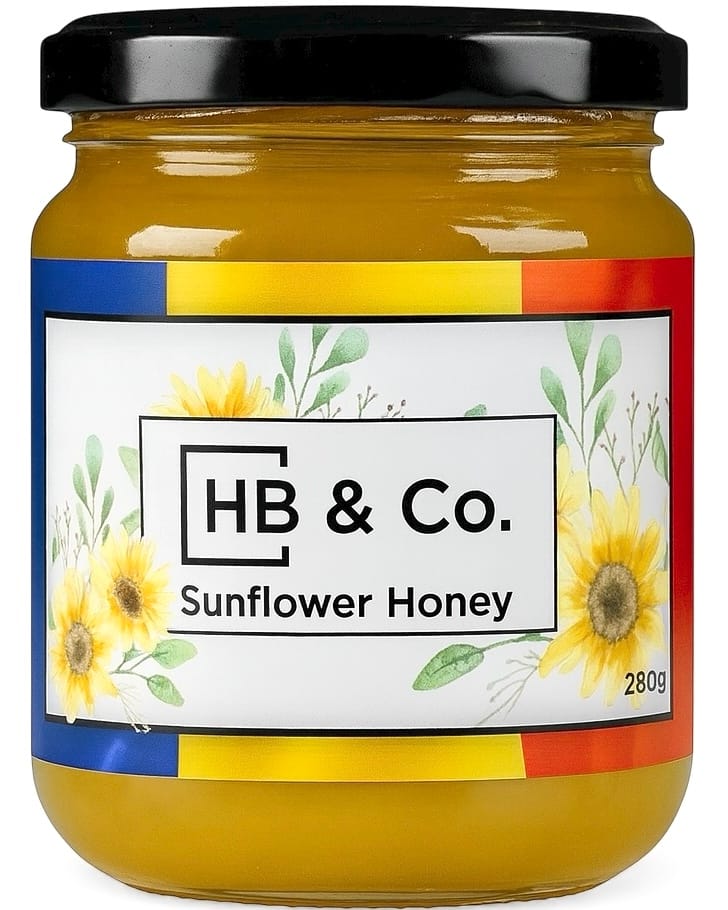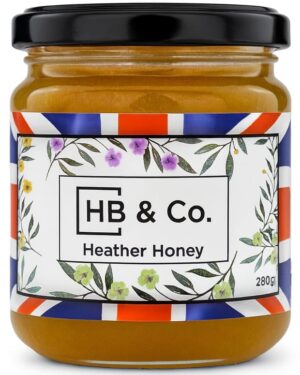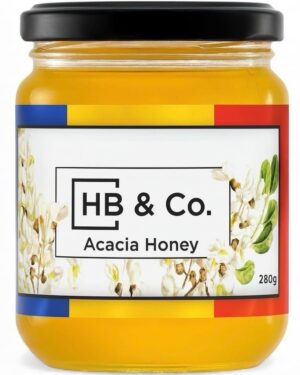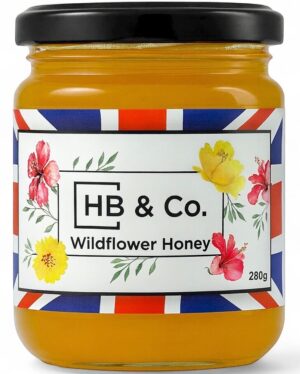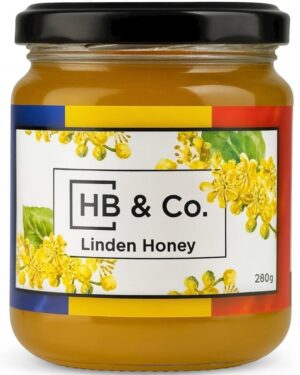Sunflower Honey
Sunflower Honey
100% Sunflower Honey, net volume 280g. At HoneyBee & Co., we work hand in hand with trusted beekeepers who share our dedication to sustainability and ethical harvesting. Each jar supports healthy bee populations, responsible beekeeping, and the preservation of wild landscapes.
Flavour Notes:
Lightly floral with buttery, caramel undertones and a smooth, sunny finish.
Best For:
Everyday sweetness, breakfast spreads, or a natural energy boost.
Ingredients:
100% pure sunflower honey; raw, unpasteurised, and naturally golden.
£10.99 — or subscribe and save 20%
Availability: In stock
Related products
Just opened my first jar of 3 which happened to be the Acacia honey….DELICIOUS…. bears no resemblance to cheap Supermarket honey…..well pleased…!😋
About Sunflower Honey
Sunflowers, the towering sentinels of vast landscapes, ardently follow the sun, bringing joy to the onlooker's eyes. These radiant blooms serve as an abundant source for bees to produce exquisite sunflower honey. Embodied with a unique medium sweetness and an intricate blend of flavours, sunflower honey is a delightful gastronomic experience. However, it's not all about the taste. This raw honey type also boasts a spectrum of health benefits, making it a real superfood.
The Labour Behind the Delicacy
Sunflower honey, primarily procured from the expansive sunflower fields spanning across the Balkans and the UK, is a labour of love. The honey quantity harvested from these regions is significant, given their large sunflower crop yield. The abundant nectar supply in these areas helps honey producers craft this unique variant.
A Closer Look at Sunflower Honey Characteristics
Among the prominent characteristics of sunflower honey is its rapid crystallisation. The raw honey forms fine crystals swiftly, bestowing it a fondant-like consistency. This fast crystallisation isn't a drawback; instead, it imparts sunflower honey with a unique mouthfeel, making it a pleasure to consume. Hence, savouring crystallised honey, with its sweet taste and intriguing texture, is an experience worth indulging in.
Sunflower Honey: An Alternative to Conventional Sweeteners
Raw sunflower honey stands as a healthier substitute for typical sweeteners. It exhibits an array of flavours, far beyond mere sweetness, thanks to the plant nectars and the health-boosting metabolites from bees. A spoonful of raw sunflower honey adds not just sweetness but a burst of intricate flavours and nutrients to your food.
Sunflower honey's nutritional composition is commendable. It has a low glucose level, making it a suitable choice for those monitoring their sugar consumption. But there's more. It's also rich in fructose, vitamins, and enzymes, which play a pivotal and important role in body metabolism. Thus, consuming sunflower honey implies enjoyment of its complex flavour along with the intake of beneficial nutrients.
Sunflower Raw Honey: A Peek into Its Origin
Sunflower honey possesses a captivating charm with its yellowish hue, reflecting its origin in sunflower fields. Whether it's the picturesque landscapes of the Balkans or the organically grown crops in the UK, the honey sourced from these sunflowers is pure and devoid of harmful substances like insecticides or harmful pollutants either. This purity and authenticity contribute to sunflower honey is often referred to as raw honey.
Beyond its sweetness, raw sunflower honey brings a range of health benefits to the table, functioning as an antibacterial and anti-inflammatory agent. The enzymes introduced into the honey by bees account for these properties. Derived from the bees' sublingual glands, these enzymes render raw sunflower pollen and honey a powerful contender among natural superfoods.
Eating Crystallised Honey: A Unique Delicacy
Crystallised honey can be savoured in numerous ways: spread on your morning toast, stirred into your porridge, or enjoyed straight from the mouth of the jar. Although its fast crystallisation implies a shorter shelf life compared to other honey types, the extraordinary taste and manifold benefits more than compensate for it.
In comparison to sunflower honey, buckwheat honey is another variant with distinct characteristics and tastes. Yet, sunflower honey's medium-sweet flavour, its yellowish colour and complex undertones make it stand out. Its fast crystallisation results in a medium intensity and its fine texture further enhances the eating experience.
Embracing the Sweetness of Sunflower Honey
Sunflower honey, the product of sunflower nectar transformed by diligent bees, is not just a sweet treat but a nutritional powerhouse. Exhibiting a unique bouquet of fresh, complex flavours, this honey is more than a simple indulgence; it is one of nature's true superfoods. The honey created by our family is 100% natural and we are very happy to be able to share with you this amazing product.
Origins: From Sunflower Fields to the Honey Jar
Primarily harvested from the expansive sunflower fields of the Balkans and the UK, sunflower honey is the result of significant hard work. These regions, known for their vast sunflower cultivation, produce an impressive amount of this unique honey thanks to the bees' unrelenting toil and the rich nectar supply.
Crystallisation: A Unique Characteristic of HoneyBee & co Raw Sunflower Honey
Among the distinct and important characteristics of sunflower honey, its rapid crystallisation stands out. This raw honey quickly forms fine crystals, giving it a fondant-like texture. This fast crystallisation is a positive characteristic not a negative; instead, it enhances the sunflower honey's sensory experience, rendering it an enjoyable gastronomic adventure.
In case you will purchase honey in a glass jar and you would prefer a more liquid version, you could always place the jar in some hot water. Careful not to place it on the stove, simply place the jar in a container with hot water and after 15 to 30 minutes you should see it de-crystallize and change colour. As the honey crystallises quickly, you might prioritize its consumption over other available jars in your home.
This operation is time-consuming and if repeated too many times, certain benefits of the honey might be lost. Honey is always better eaten fresh as it has the best flavour.
A Healthy Alternative to Conventional Sweeteners
Sunflower honey offers a healthier alternative to conventional sweeteners and it has several positive characteristics. With a complex composition far beyond its sweetness, this honey is laden with health-boosting metabolites and plant nectars. Therefore, incorporating raw sunflower honey into your diet is not merely about sweetening your food, but about enriching it with far more complex flavour, flavours and nutrients.
A Nutritional Powerhouse
The nutritional content of sunflower honey is equally impressive. With a low glucose level, it is a healthier option for those mindful of their sugar consumption. Additionally, this honey is rich in fructose, vitamins, and enzymes, essential for metabolic functions. Therefore, consuming sunflower honey allows you to enjoy its unique flavours while nourishing your body with essential nutrients.
Purity: An Inherent Quality of Sunflower Honey
Sunflower honey's purity is as captivating as its vibrant yellow hue, reminiscent of the sunflower fields it originates from. Regardless of whether it is harvested in the picturesque landscapes of the Balkans or the organically grown fields of the UK, sunflower honey remains free from harmful substances like pesticides harmful insecticides and pollutants. This purity is one reason why it's often referred to as raw honey.
Raw Sunflower Honey: A Powerful Health Ally
Raw sunflower honey is not only used to sweeten food. The honey exhibits anti-bacterial and anti-inflammatory properties due to the enzymes introduced by bees. Few people using sunflower crops realise that these enzymes, originating from the bees' sublingual glands, make their way into the honey, enhancing its health benefits. Thus, sunflower honey, in addition to its sweet taste, brings numerous health advantages to the table, earning its place among potent superfoods.
Versatility in Consumption: A Salute to Crystallised Honey
Sunflower honey, with its unique crystallised texture, can be enjoyed in various ways. Eating crystallised honey spread on your morning toast, stirred into your porridge, or savoured straight from the jar, it offers a delightful taste and an array of health benefits. Although its fast crystallisation may result in a shorter shelf-life compared to other kinds of honey, the culinary and health advantages it provides make this a worthwhile trade-off.
A Standout Amongst Honeys
While there are other types of raw honey like buckwheat honey, each with certain characteristics and its unique characteristics and taste, sunflower honey distinguishes itself with its medium-sweet flavour and complex undertones. The rapid crystallisation is unique to sunflower honey resulting in a fine texture that adds an extra layer to the honey-eating experience, making it a joy to savour.
The Journey of Sunflower Honey: From Nectar Collection to Packaging
The production process of sunflower honey is a fascinating journey from the sunflower fields to your breakfast table. It begins with the diligent work of the bees who tirelessly collect the sunflower nectar. This nectar collected is stored in the hive where the magic of honey production begins. The bees add enzymes to the nectar, which slowly transforms it into honey. The honey is then extracted from the honeycomb, strained, and finally packaged, maintaining its raw quality throughout the process.
The honey quantity produced by a colony of bees depends on several factors:
- Forage availability: Bees make honey from the nectar of flowering plants. If there is a high density of flowers in the area, bees will be able to collect more nectar, which in turn allows them to produce more honey. This is why bees often produce more honey in the spring and summer months when many plants are in bloom.
- Colony health: A healthy colony with a large number of worker bees will be more efficient at gathering nectar and producing honey than a smaller or less healthy colony. Diseases, parasites, and poor nutrition can all affect colony health and decrease honey production.
- Queen health: The queen's primary job is to lay eggs and grow the colony. A healthy, productive queen will result in a larger workforce to gather nectar, which can lead to increased honey production.
- Weather conditions: Good weather conditions are essential for bees to forage. They prefer warm, sunny days and don't venture out of their hives during rainy or cold weather. Extended periods of poor weather can limit the bees' ability to collect nectar and produce honey.
- Beekeeping practices: Beekeepers can influence honey production by managing the strength of the colonies, providing them with plenty of space to store honey, preventing diseases, and efficiently harvesting the honey while allowing the bees to remain pure.
- Genetics: Some bee breeds are more industrious and efficient honey producers than others.
The Sunflower Honey Experience: A Celebration of Natural Sweetness
Enjoying sunflower honey is not just about satisfying your sweet tooth, but experiencing the vibrancy of nature in every spoonful. As you taste the sweetness, imagine the sunflower crops bathed in sunlight, and the bees buzzing around collecting nectar. This journey of sunflower honey, from the fields to your plate, is a testament to the wonders of nature and the hard work of the humble honey bee.
How is honey measured as acidic?
The pH scale is measured from 0 to 14. Everything containing a pH under 7 is considered acidic. Liquids
with pH 7 are classified as neutral – for example, pure water. And a pH above 7 is considered alkaline.
Scientists have measured that the pH in different types of honey varies between 3.3 and 6.5,
therefore honey is acidic.
Despite being acidic honey is perfectly healthy for consumption unless you are advised to exclude it
from your diet by a specialist.
Interesting fact: Many of the healthiest foods are acidic. That includes bananas, eggplant,
cauliflower, pumpkin, nectarines, potatoes, eggs and fish.
Sunflower Honey recipe of choice:
Sunflower Honey Bread:
Ingredients:
1 ¼ cups warm water
2 Tbsp sunflower honey
2 tsp instant or active dry yeast
2 tsp sunflower oil
½ cup raw sunflower seeds
1 ½ cups whole wheat flour
½ Tbsp salt
2 cups all-purpose flour
1 large egg
Method:
1. Add the yeast and honey into warm water and let it rest for five minutes.
2. Chop the sunflower seeds and add them to a large mixing bowl with one cup of whole wheat
flour and salt. Mix.
3. Add the oil to the yeast which should be foamy and frothy in the water. Pour the liquid into the
mixing bowl with the other ingredients and stir well.
4. Add the second half of the whole wheat flour and mix again. Then add half a cup of the all-
purpose flour and mix again. The result should be a loose ball of dough.
5. Place the dough onto a floured work surface and knead for five minutes. Whilst kneading keep
adding some of the all-purpose flour so the dough becomes soft and non-sticky.
6. Place the dough back into the mixing bowl, cover it with cling film or a damp towel and let it rest
for 1 hour.
7. Once the hour is up the dough should be almost double its initial size. Then divide it in half and
form two balls. Place them on a baking tray and cover them again. Leave for 1 hour until doubled their size
again.
8. Preheat the oven to 400 degrees. Separate the egg white and yolk. Add a tablespoon to the yolk,
whisk, and brush it over the formed dough balls.
9. Carefully slice an “X” on top of each loaf with a sharp knife.
10. Bake for 25 minutes or until golden brown in the preheated oven and take the temperature
down a little bit.
11. Leave to cool down before slicing.
ENJOY this delicious and healthy goodness!
Here are a few examples of Sunflower fields in the United Kingdom:
- The Pop Up Farm, Hertfordshire: Located near Harpenden, this farm plants sunflowers every year and opens its fields to the public when they are in bloom.
- Hitchin Lavender, Hertfordshire: This farm is known for its lavender fields, but it also has a large sunflower field.
- Stanhill Farm, Kent: Located in Dartford, this farm includes a sunflower field as part of its pick-your-own produce offerings.
- Hawkswick Lodge Farm, Hertfordshire: Here too, you can enjoy the stunning views of the sunflower fields.
- Secretts Of Milford, Surrey: Secretts grow sunflowers in summer and offer pick-your-own.
- Cattows Farm, Leicestershire: They have a Sunflower Summer festival, usually in August, where visitors can wander around the sunflower fields.
- Rhossili Bay, Swansea, Wales: While not a farm, this area in Swansea is famous for the beautiful sunflowers that bloom in late summer.
Remember that the exact dates when sunflowers are in bloom can vary from year to year, depending on the weather. It's always a good idea to check with the farm for the best time to visit their sunflower fields.
Final Word
Sunflower honey, the sweet product of bees' tireless toil and sunflower nectar, is a testament to the beauty and bounty of nature. By choosing this honey, you're not just choosing a sweetener but a healthier lifestyle and a more conscious approach to nutrition. So, the next time you reach for a sweetener, consider sunflower honey, and experience the sun-kissed sweetness this superfood has to offer.
Raw Honey vs Cheap Honey
1% Minerals, Vitamins, Enzymes
6% Trisaccharide & Other Carbohydrates
7% Maltose
17% Water
31% Glucose
38% Fructose

Up to 35% Blend of EU & Non EU Honeys
Potentially containing pesticides & antibiotics
Up to 50% Water
Up to 35% High Fructose Corn Syrup
*Percentage may vary
Your Questions Answered
No. HoneyBee & co Honey is Raw Honey. Exactly how bees have made it.
No. Our Acacia Honey is produced in pure and uncontaminated natural areas and our bees are not treated with antibiotics.
Our Acacia Honey contains an Optimal water percentage between 15% and 19%. Cheap supermarket honey can have up to 50% water. This is due to either beekeeper feeding bees water with artificial sugar or they collect the honey to quickly to increase profit margins.
Nectar is a liquid secretion of flowers that bees gather. They then take out much of its water content and after adding several enzymes they produce the golden substance we call honey.
Consuming honey rather than sugar has obvious advantages. The supply to the body of energy in the form of glucose and fructose, simple sugars that do not require any digestive process. Honey also contains Vitamins and other useful enzymes.
Raw Honey is a product with many calories; approximately 320 kcal for 100g. Moderation is the key if one has a particular diet. The positive fact about honey is its sweetness. One teaspoon of honey weighs about 7g and its more than enough to sweeten your favourite cup of tea.
Raw Honey is safe and it provides many health benefits, nevertheless, it should not be cooked raw over 40 degrees. When cooked, honey becomes similar to glue and thus produces toxins. Honey's raw form is the one detaining all its main benefits and properties. By altering its chemical composition by heating or overheating the honey It may completely change its compounds leading to health hazards. Honey also contains bacteria that can harm a young baby’s intestine. To this end avoid giving honey to babies under 12 months old.
Our bees are from the Apis Mellifera from the Apidae family.
Our honey is produced on the European Continent. Our long-term goal is to partner with small beekeepers from all over the UK and Europe providing our customers with quality honey while helping increase the European bee population.
Acacia Honey Stimulates digestion cleans the liver, regulates intestinal transit. Improves heart activity and circulatory system. Helps to restore the body after effort. Stimulates the immune system. The number of red blood cells increases.
Honey is a healthier alternative to sugar, especially for diabetics. It has antioxidants that help reduce the risk of heart attacks, strokes, and some types of cancer. It lowers blood pressure and improves cholesterol values. Honey is great for healing wounds and burns.
Honey is a great solution for coughs both for children and adults.

